Country guides

Things to do in Romania
Romania has myriad sightseeing attractions on offer. Visitors can marvel at the many medieval villages and castles throughout the country, such as Brasov or Bran Castle, visit the museums or feast their eyes on the brilliant old architecture of the cities.
The National Museum of Romanian History is certainly a must when in the capital. Those who admire architecture and history should make sure to add a trip to the Stavropoleos Church and Monastery, and the Palace of Parliament to their itinerary. The Village Museum is highly recommended too, as it will transport tourists back in time with the multitude of open-air exhibits on display.
Romania also has a number of exciting festivals and events happening throughout the year, which offer visitors the opportunity to experience local culture at its best. Visitors can choose to step back into the Middle Ages at the Sighisoara Medieval Festival or watch some of the top local and international films at the Bucharest International Film Festival. For serious music-lovers, the Europafest, Bucharest's main cultural event, attracts artists, performers and festival goers from across the globe to the capital for a few nights of revelry and excellent music.
Finally, a trip to Romania would not be complete without a visit to the beautiful UNESCO Heritage site of the Painted Monasteries.
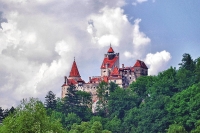
Bran Castle
Often referred to as 'Dracula's Castle', the fortified medieval Bran Castle is a national monument and landmark of Romania. Looking exactly as a vampire count's lair should, the fo…
Bran Castle
Often referred to as 'Dracula's Castle', the fortified medieval Bran Castle is a national monument and landmark of Romania. Looking exactly as a vampire count's lair should, the forbidding façade, towers and ramparts rise out of the forest, perched high on a steep cliff face against a dramatic mountain background. Despite its aesthetic, there is little evidence to suggest Vlad Tepes, the speculated inspiration for Dracula, ever lived there. Bran Castle was built between 1377 and 1388 to protect nearby Brasov from invaders. The rooms and towers surround an inner courtyard with a sculpted stone fountain. A warren of narrow, winding stairs, secret chambers and underground passageways lead between vaulted halls, a prison, a living area and watchtowers with sweeping views. The rooms are decorated with a collection of Baroque furniture, elaborately carved four-poster beds, weapons and armour dating from the 14th to 19th centuries. A fascinating site, visitors should have this near the top of their Romanian to-do list.
Website www.bran-castle.com
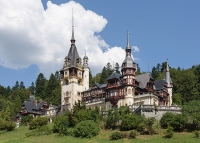
Peles Castle
The quintessential fairytale castle, complete with turrets and surrounded by mystical forests, the neo-classical Peles Castle was the summer residence of Romania's kings, and makes…
Peles Castle
The quintessential fairytale castle, complete with turrets and surrounded by mystical forests, the neo-classical Peles Castle was the summer residence of Romania's kings, and makes for a highly popular tourist attraction. Built by King Carol I in 1883, the castle is a masterpiece of German new-Renaissance architecture, its exquisite form framed by fir forests and the towering peaks of the Carpathian range. The castle's 160 rooms are lavishly decorated in ebony, mother of pearl, walnut, and leather, with crystal chandeliers, fine collections of sculptures, paintings and tapestries, and stained-glass windows and furniture. It is set within a large park with a statue garden in front. Further up the hill from the main palace is the smaller Pelisor Palace, built for Carol I's nephew and heir, and decorated in the Art Nouveau style.
Website www.peles.ro
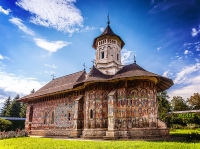
The Painted Monasteries
The 15th century painted monasteries of Southern Bucovina have been declared UNESCO World Heritage Monuments, and represent some of the greatest artistic monuments in Europe â€'…
The Painted Monasteries
The 15th century painted monasteries of Southern Bucovina have been declared UNESCO World Heritage Monuments, and represent some of the greatest artistic monuments in Europe â€' certainly a must for serious history buffs. Among the most picturesque treasures in Romania, most of the churches are fortified with strong defensive surrounding walls, which once provided protection against Turkish invaders. The exterior walls of the monasteries are richly decorated with vivid frescoes depicting dramatic Biblical scenes, intended to teach Christianity to the illiterate. The artwork has, amazingly, survived harsh exposure to the elements for over 450 years and the intense colours have been well preserved. The five main painted monasteries near Suceava are Humor, Voronet, Moldovita, Sucevita and Arbore.
Website romaniatourism.com/painted-monasteries.html
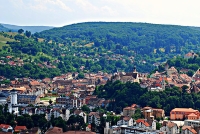
Sighisoara
Sighisoara is a beautifully preserved medieval town, renowned as the birthplace of 'Dracula', or Vlad the Impaler. It is also a UNESCO World Heritage Site and one of the seven fort…
Sighisoara
Sighisoara is a beautifully preserved medieval town, renowned as the birthplace of 'Dracula', or Vlad the Impaler. It is also a UNESCO World Heritage Site and one of the seven fortified towns founded by the Saxons in the hills of Transylvania. The hilltop citadel dominates the town, with the original medieval settlement enclosed within the fortress walls, surrounded by nine surviving towers. Visitors will love exploring the old town, with its narrow cobbled streets and steep alleyways, brightly-painted lopsided houses, ancient churches, stone archways and covered stairways, all of which are watched over by the striking Clock Tower. At the foot of the Clock Tower is the simple yellow building where Vlad was born and lived with his father, Vlad Dracul. Marked by a hanging wrought-iron dragon, it now houses a restaurant with medieval furnishings.
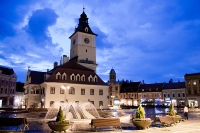
Brasov
Nestled at the foot of Mount Tâmpa is the charming medieval town of Brasov which, being one of the seven fortified towns settled by the Saxons, has a distinct Germanic flavour to …
Brasov
Nestled at the foot of Mount Tâmpa is the charming medieval town of Brasov which, being one of the seven fortified towns settled by the Saxons, has a distinct Germanic flavour to its history and culture. The Saxons built massive stone walls and seven bastions around the city that are still visible today, as well as ornate churches, elaborately trimmed buildings, and a fine central square that is said to be where the legendary Pied Piper led the children of Hamlin. Lining the square are the red-roofed merchant's houses, now occupied by cafes and shops surrounding the 15th-century Old Town Hall. The town's landmark is the impressive Gothic structure known as the Black Church, so named because a fire blackened its outer walls in 1689. Many tourists use Brasov as a base for visiting the nearby attractions such as Dracula's Castle at Bran, Râsnov Castle and the ski resorts of Sinaia and Poiana Brasov.


